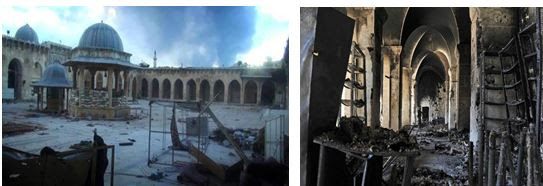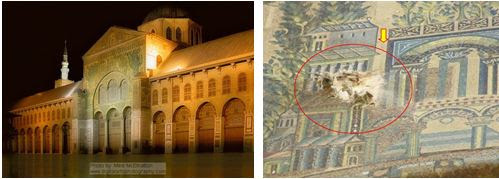by N. Mozes
Introduction
The
war raging in Syria has recently passed its thousandth day with over 120,000
people killed, hundreds of thousands wounded, and millions left homeless. The
war has destroyed the country's social and economic infrastructure and has also
caused irreversible damage to some of the country's most famous sites, which
are included in UNESCO's list of world heritage sites, such as the old cities
of Damascus and Aleppo. On July 2, 2013, UNESCO director-general Irina Bokova expressed
deep concern for Syria's cultural heritage, noting that its loss represented a loss
for all mankind. Amnesty International's senior crisis response advisor Donatella Rovera said
in August 2013 during a visit to Aleppo: "The city is completely
destroyed, its inhabitants are fleeing. The danger that we warned of concerning
the heritage sites has now materialized." In addition, hundreds of mosques
and churches, as well as statues of historic Muslim leaders, have been
destroyed either by the Assad regime or by its opponents, and large-scale theft
and plunder of antiquities has been reported. Some of the damage to heritage
sites and places of worship and the plunder of antiquities was the work of radical
Islamic groups such as the Islamic State in Iraq and Syria (ISIS) and Jabhat Al-Nusra,
who are ideologically motivated to destroy churches and statues.
Not
surprisingly, as part of the propaganda war between the Assad regime and the
Syrian opposition, each side blames the other for the damage and plunder of heritage sites
and places of worship.
This report will survey this aspect of the war taking
place in Syria:
Places of Worship Destroyed
Mosques
As soon as the uprising in Syria
began, mosques, like public squares, became sites of clashes between the regime
forces and demonstrators who used them as a departure point for many anti-regime
demonstrations and as places of refuge. The Syrian Network for Human Rights, an
opposition body, estimates that about 1,450 mosques were damaged or destroyed
throughout the country during the fighting, including historic mosques. The
most famous of these is Aleppo's Umayyad mosque dating from the eighth century.
Aleppo's old city and this mosque were at the epicenter of fighting between the
insurgents and the regime, and according to Donatella Rovera, Amnesty's senior
crisis response advisor, who visited Aleppo in August 2013, "the city was completely
destroyed". The opposition claims that regime forces booby-trapped the eastern
part of the wall surrounding the mosque and detonated a large part of the
mosque itself. According to reports the site's library and minaret were
destroyed.

Aleppo's
Umayyad mosque before the fighting
(image: al-sharq.com, October 15, 2011)

The mosque in its present state
(images:aksalser.com, March 2, 2013; alwatanalarabi.com,
November 22, 2013)
Damascus' eighth-century
Umayyad mosque was also damaged by artillery shells, although less severely. Located
in Damascus' old city, which is included in UNESCO's list of world heritage
sites, this mosque is considered one of the seven wonders of Islam and it is the
fourth most famous mosque following the great mosques of Mecca and Medina and
Al-Aqsa in Jerusalem. According to reports, the western façade of the Umayyad
mosque's patio was damaged by an artillery shell that destroyed part of the mosaic
on the site's great gate.

The Umayyad mosque in Damascus and the damaged mosaic
(images: digitalartsphotography.com; .all4syria.net, November
20, 2013)
Another
historic building damaged in the fighting is Homs' Khalid Ibn Al-Walid Mosque,
built in the 19th century on the ruins of a 13th century mosque.

The Khalid Ibn Al-Walid Mosque before and after being hit by an artillery shell
(images:aksaler.com, July 7, 2013; radiosawa.com,
April 17, 2013)
According to the locals, regime
and Hizbullah forces that took control of the site seized everything that was
in it, including an alms box. Their actions also had a sectarian aspect, as
they converted the Sunni mosque into a Shi'ite one and began sounding the
Shi'ite version of the call for prayer from its minarets, in order to emphasize
their control over the area and provoke the locals. It was also reported that
regime and Hizbullah forces wrote Shi'ite slogans on the walls of Sunni mosques
in the city of Homs.
Source: http://www.memri.org/report/en/0/0/0/0/0/0/7747.htm
Copyright - Original materials copyright (c) by the authors.
No comments:
Post a Comment